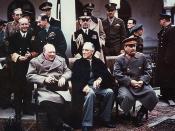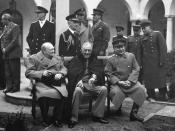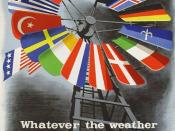The June 1945, the Yalta conference was used to decide the future of Europe. Germany would be divided into four zones. Each one would be occupied by one of the Allies: Britain, the USA, France, and the USSR. Berlin would also be divided into four sectors. Germany would be forced to pay reparations, half of which would go to the USSR. Countries that had been occupied by Germany would be free to elect governments of their choice. The USSR would declare war on Japan three months after the end of the war against Germany. The United Nations, an organisation to discuss and settle world problems, would be set up. In July 1945, there was another conference, the Potsdam conference. This conference confirmed the decisions made at Yalta, also was to decide on the 'carving up of Europe', Britain, USA, USSR, France. When the war had ended many people believed that the League of Nations should be reformed, but the new organisation was established, the United Nations (UN).
The United Nations was to give a much stronger position to the traditional great powers through the UN Security Council. Several of the aims of the old League of Nations and methods were transferred into the new organisation in 1945.
In addition, it was realised that the European economy had been demolished by the war and help would be needed to restore and rebuild some countries. and China would negotiate settlements of land. What Europe needed now was money; this came from the American government. In June 1947, General George Marshall, the secretary of state for America, offered Europe a helping hand. Marshall outlined a new program of foreign aid for war-ravaged Europe. This was authorised by the United States Congress in 1948. The Marshall Plan, would grant credit to individual European states,


